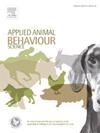Owner-reported breed differences in the behaviour of ridden horses
IF 2.2
2区 农林科学
Q1 AGRICULTURE, DAIRY & ANIMAL SCIENCE
引用次数: 0
Abstract
Domestic horses are often selected for specific activities according to anecdotal breed-specific behavioural traits some of which are tested in competition environments and many of which relate to human safety. On the other hand, breeds are often celebrated for their versatility. The purpose of the current study was to investigate breed differences in ridden horse behaviour, as reported by horse carers (“owners”) through the Equine Behaviour Assessment and Research Questionnaire (E-BARQ). From a pool of owners’ reports (n = 8151) in the E-BARQ database, selection criteria were applied to reports as follows: purebred only; horse ridden within the last six months; only the first record of the horse taken if there were multiple records per horse; and only breeds with at least 35 horses. This generated a sample of reports on 1635 horses for the current study. Fourteen previously reported behavioural constructs were considered, namely trainability, safe to ride, boldness, easy to handle, easy to ride, easy to stop, unlikely to stall (unlikely to baulk), approachable, bold with non-humans, novel object confidence, tolerance of tactile stimulation, easy to load, tolerance of isolation and repetitive behaviours. For each of these constructs, an ordinal logistic regression model was fitted to the score data, with breed as the explanatory variable. The results confirmed that there were significant differences among the 14 breeds in 12 of the 14 construct scores, the exceptions being easy to handle and boldness with non-humans. The constructs that showed the most difference according to breed were repetitive behaviours. As expected, there was some weak clustering of constructs, e.g. safe, easy to ride, easy to stop, and unlikely to stall. These are the traits that make riding horses useful. Furthermore, the current findings suggest that equine behaviourists should consider E-BARQ profiles of their patients to establish how different they are from a breed average. With more knowledge surrounding what is typical behaviour for particular horse breeds, trainers and riders will be able to adjust their training and management techniques to better suit their individual horses.
求助全文
约1分钟内获得全文
求助全文
来源期刊

Applied Animal Behaviour Science
农林科学-行为科学
CiteScore
4.40
自引率
21.70%
发文量
191
审稿时长
18.1 weeks
期刊介绍:
This journal publishes relevant information on the behaviour of domesticated and utilized animals.
Topics covered include:
-Behaviour of farm, zoo and laboratory animals in relation to animal management and welfare
-Behaviour of companion animals in relation to behavioural problems, for example, in relation to the training of dogs for different purposes, in relation to behavioural problems
-Studies of the behaviour of wild animals when these studies are relevant from an applied perspective, for example in relation to wildlife management, pest management or nature conservation
-Methodological studies within relevant fields
The principal subjects are farm, companion and laboratory animals, including, of course, poultry. The journal also deals with the following animal subjects:
-Those involved in any farming system, e.g. deer, rabbits and fur-bearing animals
-Those in ANY form of confinement, e.g. zoos, safari parks and other forms of display
-Feral animals, and any animal species which impinge on farming operations, e.g. as causes of loss or damage
-Species used for hunting, recreation etc. may also be considered as acceptable subjects in some instances
-Laboratory animals, if the material relates to their behavioural requirements
 求助内容:
求助内容: 应助结果提醒方式:
应助结果提醒方式:


